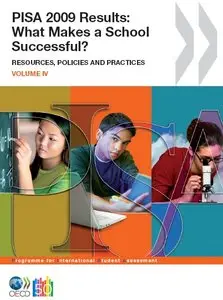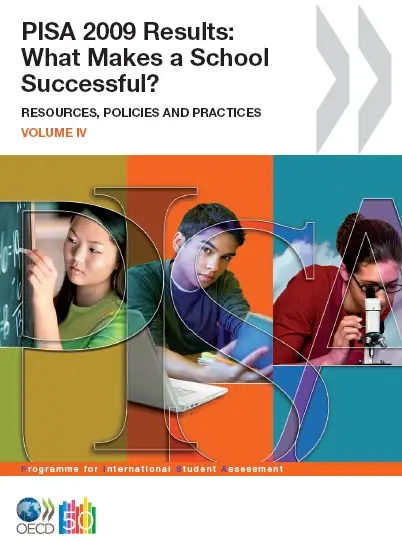PISA 2009 Results: What Makes a School Successful? Resources, Policies and Practices (Volume IV)
OECD | 07 Dec 2010 | ISBN: 9264091559 | 308 pages | PDF | 6 MB
OECD | 07 Dec 2010 | ISBN: 9264091559 | 308 pages | PDF | 6 MB
This volume of PISA 2009 results examines how human, financial and material resources, and education policies and practices shape learning outcomes.
Following an introduction to PISA and a Reader's Guide explaining how to interpret the data, Chapter 1 presents a summary of features shared by "successful" school systems.
Chapter 2 details how resources, policies and practices relate to student performance.
Chapter 3 provides detailed descriptions and in-depth analyses of selected organisational features (how students are sorted into grades, schools, and programmes, school autonomy, etc.) of schools and systems and how those aspects affect performance.
Chapter 4 describes and analyzes key aspects of the learning environment (behaviours, discipline, parental involvement, school leadership, etc.) and how they affect performance.
The final chapter discusses the policy implications of the findings. Annexes provides detailed statistical data and technical background.
Table of Contents
Executive summary
Introduction to PISA
Reader’s Guide
Chapter 1 Some Features shared by high-performing school systems
Performance differences among countries, schools and students
Common characteristics of successful school systems
The learning environment inside schools and classrooms
The PISA 2009 evidence base
Chapter 2 How resources, policies and practices are related to student pe rformance
How PISA examines resources, policies, practices and learning outcomes
• How selecting and grouping students are related to student performance
• How the governance of school is related to student performance
• How assessment and accountability policies are related to student performance
• How resources invested in education are related to student performance
• How resources, policies and practices are related to each other
How the learning environment is related to student performance
How the features of schools and school systems are interrelated
Chapter 3 How schooling is Organised
Selecting and grouping students
• Vertical differentiation
• Horizontal differentiation at the system level
• Horizontal differentiation at the school level
• Country profiles in selecting and grouping students
Governance of school systems
• School autonomy
• School choice
• Public and private stakeholders
• Country profiles in the governance of school systems
Assessment and accountability policies
• Assessment practices and purposes
• Accountability arrangements
• Country profiles in assessment and accountability policies
Resources invested in education
• Time resources
• Human resources
• Material resources
• Spending on education
• Country profiles in resources invested in education
Chapter 4 The Learning Environment
Teacher-student relations
Disciplinary climate
How teachers stimulate students’ engagement with reading
Student-related factors affecting school climate
Teacher-related factors affecting school climate
Parents’ involvement in and expectations of schooling
Principal leadership
Relationship between learning environment and school climate variables
Policy Implications
A commitment to children matters, as does the belief that all students can attain high levels of achievement
Setting standards and showing students how to meet them matters
Autonomy matters when combined with accountability
How resources are allocated in schools matters more than overall spending
The school climate and teacher-student relations matter
References
Annex A Technical Background
Annex A1: C onstruction of reading scales and indices from the student, school
and parent context questionnaires.114
Annex A2: T he PISA target population, the PISA samples and the definition of schools
Annex A3: Standard errors, significance tests and subgroup comparisons
Annex A4: Quality assurance
Annex A5: T echnical notes on analyses in Volume IV
Annex A6: T esting results in Volume IV
Annex B Tabl es of results
Annex B1: Results for countries and economies
Annex B2: Results for regions within countries
Annex C The development and impl ementation of PISA – A coll aborative effort
with TOC BookMarkLinks
More : You find here



